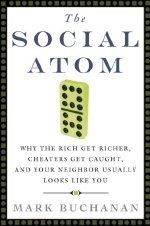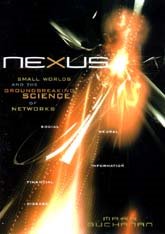I wrote a little in The Social Atom on the topic of crime and its dynamics. An old idea in the field holds that crime has economic origins; that it arises out of the cost-benefit analysis of the criminal, who decides, given his or her situation, that the benefits of breaking the law outweigh the risks. Read economist Gary Becker's 1992 Nobel Prize Lecture, and you see that this influential way of thinking about crime -- thrust upon him by a minor experience in his own life -- stimulated his efforts to apply "rational choice" theory more broadly:
I began to think about crime in the 1960s after driving to Columbia University for an oral examination of a student in economic theory. I was late and had to decide quickly whether to put the car in a parking lot or risk getting a ticket for parking illegally on the street. I calculated the likelihood of getting a ticket, the size of the penalty, and the cost of putting the car in a lot. I decided it paid to take the risk and park on the street. (I did not get a ticket.)
As I walked the few blocks to the examination room, it occurred to me that the city authorities had probably gone through a similar analysis. The frequency of their inspection of parked vehicles and the size of the penalty imposed on violators should depend on their estimates of the type of calculations potential violators like me would make.
In this way of seeing crime as a rational response to economic conditions, Becker was reacting to the earlier view which saw crime as the outcome of mental deficiencies and aberrations. Neither of these perspectives, at least as naively interpreted, has proven very successful in accounting for the data on crime. In an important study a few years ago, economists Edward Glaeser, Bruce Sacerdote and Jose Scheinkman looked at how crime rates fluctuate from place to place, within nations or within individual cities, and found variations far too strong to be attributed to economic conditions alone. As they pointed out,
...even casual empiricism suggests that differences in observable local area characteristics can account for little of the variation in crime rates over space. ...The 51st precinct of New York City has 0.046 crimes per capita while the wealthier 49th precinct has 0.116 crimes per capita. ...More rigorously, we generally find that less than 30 percent of the variation of cross-city or cross-precint crime rates can be explained by local area attributes.
Rather, they suggested that "social interactions" of some kind must be at work; for example, the way a culture of crime in a particular community can make it more likely for young people to become criminals, so that criminal behavior propagates on its own. One person's decision to commit a crime makes it more likely that their friend or brother will commit a crime. There is, no doubt, a strong element of truth in this, but I just learned about another fascinating perspective on crime, with perhaps more specific applicability, which sees it dynamics as a process quite closely akin to physics or chemistry -- it takes a step back toward Becker's view, seeing crime as a somewhat mechanical and unsurprising outcome under the right conditions, yet without being quite so insistent on the "rationality" of the perpetrator.
I've been listening to a recent lecture (podcast and pdf slides available here) by criminologist Marcus Felson of Rutgers University. Nearly thirty years ago, as a young professor, he introduced a way of looking at crime called "routine activity" theory. In his lecture, he says, the idea...
... was considered very strange at the time, and may be still. We argued that to study crime you needn't worry so much about offenders; that indeed an illegal act involves an offender and a target and the absence of a guardian against the crime. There's a physical convergence that has to occur, and if the physical convergence does not occur, then a normal crime does not occur. As a result, the targets for crime may be more important than the offenders, and the guardians for crime, the people who would stop a crime, may be more important than offenders.
This makes crime much more a physical phenomenon.
In Felson's view of crime, the important factors are offenders, targets and guardians, and the process is largely mathematical, aking to a kind of basic social chemistry. When offenders come into contact with targets, crime has a chance of happening, unless a guardian happens to be there (and this needn't be a police figure, but could be just any ordinary person who happens to be watching a car, house, etc.) So understanding crime, and how to prevent it, means looking at all the details that influence how and when offenders and targets make contact in the absence of guardians. Often, this comes down to relatively simple details of the exposure of targets and the flows of people. For example, of two identical houses, one on a main street and another on a smaller street requiring two further turns to be reached, the latter turns out to be much less likely to be burgled, simply because its harder to reach (Patricia Brantingham mentioned this example in her lecture from the same conference.)
I'm on a bit of a push to explore this area over the next week or so, so I'll write more in coming days on the chemistry of crime, and how it is being increasingly applied to make a real difference. A relatively new idea called "situational crime prevention" takes this chemistry view seriously, and tries to prevent crime by taking away the conditions under which the necessary "reactions" can take place. Situational preention, as Felson says in his lecture,
...focuses on the very local conditions or very direct conditions that physically make it more difficult to carry out a crime. And increasingly we've discovered ... that crime prevented here does not simply crop up elsewhere...that [crime] displacement is not nearly the problem it was once thought to be... and that crime really can be prevented substantially by rather direct methods ...
From what I know so far, this does seem to fit the them of thinking more about patterns than people. The social world is a physical process with human flows and reactions between people of various sorts, and we can make a difference by thinking specifically in those terms.




8 comments:
Marcus Felson's work sounds like Jane Jacobs's suggestions about reducing crime in The Death and Life of American Cities. I don't have the book with me, but she points out that well-lit well-populated city streets (full of Felson's "guardians") could be safer than less-populated non-visible areas like suburbs or housing projects. There's a calculation that has to be done since the density of targets is lower, but I think Jacobs would posit that if cities make the number of interactions go up such that guardian density rises as fast or faster than target density, crime will go down.
Great story as for me. It would be great to read more about that theme. Thnx for posting this information.
Sexy Lady
London escort
I consider everyone ought to browse on it.
INDIA TOUR BY TEMPO TRAVELER (Rajasthan Tour Operator) Provides Rajasthan Tour Package, best Rajasthan tour Package, Cheap Rajasthan Tour Packages
Our Financial Management services in Jaipur provides you with Financial Management services to provide Financial Services in Mumbai/Jaipur/India
volvo bus hire jaipur,volvo bus in jaipur,volvo bus on hire jaipur,volvo bus hire in jaipur,volvo bus hire jaipur, rent volvo bus jaipur,hire volvo bus in jaipur,volvo bus on rental jaipur,volvo bus rental in jaipur,volvo bus rental jaipur
Additionally, admissions consultants in Jaipur may assist with preparing personal statements, completing applications, interview preparation, and receiving letters of recommendation from teachers or other professionals
replica bags los angeles get more j3n97k9p48 7a replica bags useful link m7n93c1v99 replica ysl handbags replica bags manila e7l26v5v91 click this link here now e6f97i7d74 Louis Vuitton replica Bags replica bags hermes
Post a Comment